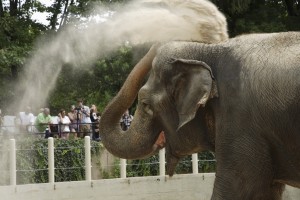10 Things You Didn’t Know About Asian Elephants
/https://tf-cmsv2-smithsonianmag-media.s3.amazonaws.com/filer/ambday.jpg)
Tomorrow, the National Zoo and the embassies of Sri Lanka, Thailand and India will celebrate Asian elephants. Only 35,000 to 50,000 Asian elephants survive in the world, and of those, 15,000 are in human care. The National Zoo has three: Kandula, Shanthi and Ambika, who at 61 is the third oldest Asian elephant in North America.
The celebration will include elephant baths, training sessions, Sri Lankan dancers and information about the diet and history of Asian elephants. Maybe you have assumed that all elephants are basically the same, but Asian elephants are actually more closely related to mammoths than their modern-day African counterparts. Here are ten other things you probably didn't know about Asian elephants:
1. Even though they have five toes on both their front and back feet, Asian elephants usually only have four toenails on their back feet.
2. Asian elephants have one "finger" (really, a small protrusion) at the upper tip of their trunk with a pad on the opposite side. They pick up items similar to the way a person does when wearing mittens. Shanthi’s finger is exceptionally long, and she uses it to check locks and open food containers.
3. As they age, Asian elephants lose some of the pigment in their skin, which causes them to look pink in some areas, most often on their trunk. If you look at Ambika's trunk and ears, you can see where her skin has turned pink.
4. Peanut-loving elephants are a myth. Elephants, Asian or otherwise, don't eat peanuts in the wild, nor are peanuts a typical diet for captive elephants. In fact, most elephants don’t even appear to like them very much.
5. The height of an Asian or African elephant at the shoulder is roughly equivalent to the circumference of their front foot multiplied by two.
6. An Asian elephant’s trunk can hold about 2.5 gallons of water at a time. But it's really a nose; they don't drink from it. Elephants draw water up into their trunk and then blow it out into their mouths.
7. Asian elephants are one of only nine species that can recognize themselves in a mirror. Others include bottlenose dolphins, magpies, gorillas, chimpanzees and, of course, humans, but not until they're a few months old.
8. Ambika loves to throw dirt. She can cover every inch of her body in mud on a rainy day and dip one shoulder down to dump sand all over the keeper standing next to her.
9. Shanthi was rescued from a well in Sri Lanka when she was a couple of months old and was bottle fed for most of her first year. In 1976, the children of Sri Lanka gave one-year-old Shanthi to the children of the United States as a bicentennial gift.
10. Kandula, who was born in 2001, was only the second Asian elephant to be produced by artificial insemination, a technique that was developed by National Zoo scientists and their German collaborators.
Now that you know some more about Asian Elephants, show it off at the National Zoo's Celebrate Asian Elephants day, tomorrow from 10 a.m. to 4 p.m.
